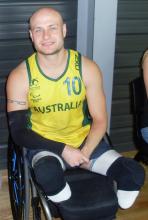Everyone has a Shot at the Podium in Wheelchair Rugby
The sport was invented in Canada and is still affectionately known as Murderball, its original name. 02 May 2012 By IPC“It’s not a game for the faint of heart.”
It’s a game of skill, speed and impacts.
And this year’s Wheelchair Rugby event is set to be the most competitive a Paralympic Games has ever seen.
Eight teams will thrash it out against each other: Belgium, Sweden, Great Britain, France, Canada, USA, Australia and Japan – all of who have a good chance of making it to the podium.
“I’m expecting that this is going to be the most competitive closest-fought competition that we’ve had at a Paralympic Games,” said Eron Main, Secretary General International Wheelchair Rugby Federation.
“There is not going to be a team in the competition that doesn’t deserve to be there. There’s not a team in this tournament that doesn’t have a shot at the podium.”
With event-specific tickets sold out for Wheelchair Rugby, the only chance that spectators have of seeing the sport is to buy an Olympic Park day pass when tickets go back on sale.
Main is confident that as soon as spectators see the sport, they will be hooked.
“Anyone who’s ever seen it doesn’t need to know why it’s going to be one of the most exciting sports,” he said. “People are going to see things that they’ve never seen before. They’re going to see people do things that they didn’t think were possible.”
“It’s a full contact sport with wheelchair on wheelchair. The strength, the skill and the speed of the players is incredible. It will suck you in in the first 30 seconds and you will want to see every match”
Wheelchair rugby is a team sport for male and female players with a disability affecting both the upper and lower limbs.
The aim of the sport is to carry the ball across the goal line like in rugby or Amercian football.
Contact, as with rugby, is an integral part of the game. Tackling can be used offensively to create openings for the ball carrier to score, and defensively, to strike and hold the opposing players so they can’t advance the ball.
Though the aim of a tackle is to stop the chair, players regularly come out of their chairs.
“When they’re moving that fast and someone hits you and stops you cold, you lose a lot of momentum and players will keep moving and go over,” said Main “Fundamentally it’s about stopping them and it’s pure physics that puts them on the floor.”
The sport is a dribbling sport, so the ball carrier has to bounce or pass the ball every 10 seconds, they have to advance the ball to their side of the court within 12 seconds, and they have 40 seconds to score a goal.
Wheelchair Rugby was invented in 1977 in Canada by a group of disabled athletes who were looking for a team sport to play. Because a lot of the players had disabilities affecting their upper bodies, they wanted an alternative to wheelchair basketball, which required stronger ball handling skills.
“They wanted a sport that they could play and be the leaders of it,” said Main.
The game, originally called Murderball, expanded from Canada to American and then on to Great Britain. By 2011, there were 26 countries active in the sport.
“It’s now called Wheelchair Rugby… apparently we wouldn’t be in the Parlaympics if we still called it Murderball,” said Main.
“It’s not a game for the faint of heart.”

 Facebook
Facebook
 Instagram
Instagram
 Twitter
Twitter
 Youtube
Youtube
 TikTok
TikTok
 Newsletter Subscribe
Newsletter Subscribe



